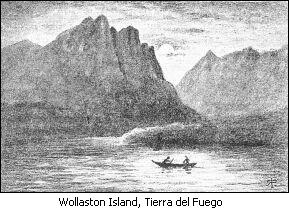

Strait of Magellan—Port Famine—Ascent of Mount Tarn—Forests—Edible fungus—Zoology—Great Seaweed—Leave Tierra del Fuego—Climate—Fruit-trees and productions of the southern coasts—Height of snow-line on the Cordillera—Descent of glaciers to the sea—Icebergs formed—Transportal of boulders—Climate and productions of the Antarctic Islands—Preservation of frozen carcasses—Recapitulation.
In the end of May 1834 we entered for a second time the eastern mouth of the Strait of Magellan. The country on both sides of this part of the Strait consists of nearly level plains, like those of Patagonia. Cape Negro, a little within the second Narrows, may be considered as the point where the land begins to assume the marked features of Tierra del Fuego. On the east coast, south of the Strait, broken park-like scenery in a like manner connects these two countries, which are opposed to each other in almost every feature. It is truly surprising to find in a space of twenty miles such a change in the landscape. If we take a rather greater distance, as between Port Famine and
Gregory Bay, that is about sixty miles, the difference is still more wonderful. At the former place we have rounded mountains concealed by impervious forests, which are drenched with the rain brought by an endless succession of gales; while at Cape Gregory there is a clear and bright blue sky over the dry and sterile plains. The atmospheric currents,1 although rapid, turbulent, and unconfined by any apparent limits, yet seem to follow, like a river in its bed, a regularly determined course.
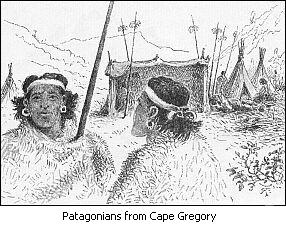
During our previous visit (in January), we had an interview at Cape Gregory with the famous so-called gigantic Patagonians, who gave us a cordial reception. Their height appears greater than it really is, from their large guanaco mantles, their long flowing hair, and general figure: on an average their height is about six feet, with some men taller and only a few shorter; and the women are also tall; altogether they are certainly the tallest race which we anywhere saw. In features they strikingly
1. The south-westerly breezes are generally very dry. January 29th, being at anchor under Cape Gregory: a very hard gale from west by south, clear sky with few cumuli; temperature 57°, dew-point 36°,—difference 21°. On January 15th, at Port St. Julian: in the morning light winds with much rain, followed by a very heavy squall with rain,—settled into heavy gale with large cumuli,—cleared up, blowing very strong from south-south-west. Temperature 60°, dew-point 42°,—difference 18°.
resemble the more northern Indians whom I saw with Rosas, but they have a wilder and more formidable appearance: their faces were much painted with red and black, and one man was ringed and dotted with white like a Fuegian. Captain Fitz Roy offered to take any three of them on board, and all seemed determined to be of the three. It was long before we could clear the boat; at last we got on board with our three giants, who dined with the Captain, and behaved quite like gentlemen, helping themselves with knives, forks, and spoons: nothing was so much relished as sugar. This tribe has had so much communication with sealers and whalers, that most of the men can speak a little English and Spanish; and they are half civilised, and proportionally demoralised.
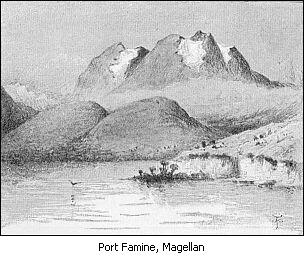
The next morning a large party went on shore, to barter for skins and ostrich-feathers; fire-arms being refused, tobacco was in greatest request, far more so than axes or tools. The whole population of the toldos, men, women, and children, were arranged on a bank. It was an amusing scene, and it was impossible not to
like the so-called giants, they were so thoroughly good-humoured and unsuspecting: they asked us to come again. They seem to like to have Europeans to live with them; and old Maria, an important woman in the tribe, once begged Mr. Low to leave any one of his sailors with them. They spend the greater part of the year here; but in summer they hunt along the foot of the Cordillera: sometimes they travel as far as the Rio Negro, 750 miles to the north. They are well stocked with horses, each man having, according to Mr. Low, six or seven, and all the women, and even children, their one own horse. In the time of Sarmiento (1580) these Indians had bows and arrows, now long since disused; they then also possessed some horses. This is a very curious fact, showing the extraordinarily rapid multiplication of horses in South America. The horse was first landed at Buenos Ayres in 1537, and the colony being then for a time deserted, the horse ran wild;1 in 1580, only forty-three years afterwards, we hear of them at the Strait of Magellan! Mr. Low informs me, that a neighbouring tribe of foot-Indians is now changing into horse-Indians: the tribe at Gregory Bay giving them their worn-out horses, and sending in winter a few of their best skilled men to hunt for them.
June 1st.—We anchored in the fine bay of Port Famine. It was now the beginning of winter, and I never saw a more cheerless prospect; the dusky woods, piebald with snow, could be only seen indistinctly through a drizzling hazy atmosphere. We were, however, lucky in getting two fine days. On one of these, Mount Sarmiento, a distant mountain 6800 feet high, presented a very noble spectacle. I was frequently surprised, in the scenery of Tierra del Fuego, at the little apparent elevation of mountains really lofty. I suspect it is owing to a cause which would not at first be imagined, namely, that the whole mass, from the summit to the water's edge, is generally in full view. I remember having seen a mountain, first from the Beagle Channel, where the whole sweep from the summit to the base was full in view, and then from Ponsonby Sound across several successive ridges; and it was curious to observe in the latter case, as each fresh ridge afforded fresh means of judging of the distance, how the mountain rose in height.
Before reaching Port Famine, two men were seen running along the shore and hailing the ship. A boat was sent for them.
1. Rengger, Natur. der Saugethiere von Paraguay. S. 334.
They turned out to be two sailors who had run away from a sealing-vessel, and had joined the Patagonians. These Indians had treated them with their usual disinterested hospitality. They had parted company through accident, and were then proceeding to Port Famine in hopes of finding some ship. I daresay they were worthless vagabonds, but I never saw more miserable-looking ones. They had been living for some days on mussel-shells and berries, and their tattered clothes had been burnt by sleeping so near their fires. They had been exposed night and day, without any shelter, to the late incessant gales, with rain, sleet, and snow, and yet they were in good health.

During our stay at Port Famine, the Fuegians twice came and plagued us. As there were many instruments, clothes, and men on shore, it was thought necessary to frighten them away. The first time a few great guns were fired, when they were far distant. It was most ludicrous to watch through a glass the Indians, as often as the shot struck the water, take up stones, and, as a bold defiance, throw them towards the ship, though about a mile and a half distant! A boat was then sent with orders to fire a few musket-shots wide of them. The Fuegians hid themselves behind the trees, and for every discharge of the muskets they fired their arrows; all, however, fell short of the boat, and the officer as he pointed at them laughed. This made the Fuegians frantic with passion, and they shook their mantles in vain rage. At last, seeing the balls cut and strike the trees, they ran away, and we were left in peace and quietness. During the former voyage the Fuegians were here very troublesome, and to frighten them a rocket was fired at night over their wigwams; it answered effectually, and one of the officers told me that the clamour first raised, and the barking of the dogs, was quite ludicrous in contrast with the profound silence which in a minute or two afterwards prevailed. The next morning not a single Fuegian was in the neighbourhood.
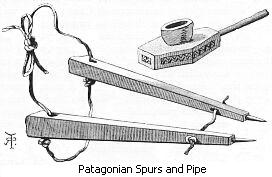
When the Beagle was here in the month of February, I started one morning at four o'clock to ascend Mount Tarn, which is 2600 feet high, and is the most elevated point in this immediate district. We went in a boat to the foot of the mountain (but unluckily not to the best part), and then began our ascent. The forest commences at the line of high-water mark, and during the first two hours I gave over all hopes of reaching the summit. So thick was the wood, that it was necessary to have constant recourse to the compass; for every landmark, though in a mountainous country, was completely shut out. In the deep ravines the death-like scene of desolation exceeded all description; outside it was blowing a gale, but in these hollows not even a breath of wind stirred the leaves of the tallest trees. So gloomy, cold, and wet was every part, that not even the fungi, mosses, or ferns could flourish. In the valleys it was scarcely possible to crawl along, they were so completely barricaded by great mouldering trunks, which had fallen down in every direction. When passing over these natural bridges, one's course was often arrested by sinking knee deep into the rotten wood; at other times, when attempting to lean against a firm tree, one was startled by finding a mass of decayed matter ready to fall at the slightest touch. We at last found ourselves among the stunted trees, and then soon reached the bare ridge, which conducted us to the summit. Here was a view characteristic of Tierra del Fuego; irregular chains of hills, mottled with patches
of snow, deep yellowish-green valleys, and arms of the sea intersecting the land in many directions. The strong wind was piercingly cold, and the atmosphere rather hazy, so that we did not stay long on the top of the mountain. Our descent was not quite so laborious as our ascent, for the weight of the body forced a passage, and all the slips and falls were in the right direction.
I have already mentioned the sombre and dull character of the evergreen forests,1 in which two or three species of trees grow, to the exclusion of all others. Above the forest land there are many dwarf alpine plants, which all spring from the mass of peat, and help to compose it: these plants are very remarkable from their close alliance with the species growing on the mountains of Europe, though so many thousand miles distant. The central part of Tierra del Fuego, where the clay-slate formation occurs, is most favourable to the growth of trees; on the outer coast the poorer granitic soil, and a situation more exposed to the violent winds, do not allow of their attaining any great size. Near Port Famine I have seen more large trees than anywhere else: I measured a Winter's Bark which was four feet six inches in girth, and several of the beech were as much as thirteen feet. Captain King also mentions a beech which was seven feet in diameter seventeen feet above the roots.

There is one vegetable production deserving notice from its importance as an article of food to the Fuegians. It is a globular, bright-yellow fungus, which grows in vast numbers on the beech-trees. When young it is elastic and turgid, with a smooth surface; but when mature, it shrinks, becomes tougher, and has its entire surface deeply pitted or honeycombed, as represented in the figure at right. This fungus belongs to a new and curious genus;1 I found a second
1. Captain Fitz Roy informs me that in April (our
October) the leaves of those trees which grow near the base of the
mountains change colour, but not those on the more elevated parts.
I remember having read some observations, showing that in England
the leaves fall earlier in a warm and fine autumn than in a late
and cold one. The change in the colour being here retarded in the
more elevated, and therefore colder situations, must be owing to
the same general law of vegetation. The trees of Tierra del Fuego
during no part of the year entirely shed their leaves.
2. Described from my specimens and notes by the Reverend J. M.
Berkeley in the Linnean Transactions (vol. xix, p. 37),
under the name of Cyttaria Darwinii: the Chilean species is the C.
Berteroii. This genus is allied to Bulgaria.
species on another species of beech in Chile: and Dr. Hooker informs me that just lately a third species has been discovered on a third species of beech in Van Dieman's Land. How singular is this relationship between parasitical fungi and the trees on which they grow, in distant parts of the world! In Tierra del Fuego the fungus in its tough and mature state is collected in large quantities by the women and children, and is eaten un-cooked. It has a mucilaginous, slightly sweet taste, with a faint smell like that of a mushroom. With the exception of a few berries, chiefly of a dwarf arbutus, the natives eat no vegetable food besides this fungus. In New Zealand, before the introduction of the potato, the roots of the fern were largely consumed; at the present time, I believe, Tierra del Fuego is the only country in the world where a cryptogamic plant affords a staple article of food.
The zoology of Tierra del Fuego, as might have been expected from the nature of its climate and vegetation, is very poor. Of mammalia, besides whales and seals, there is one bat, a kind of mouse (Reithrodon chinchilloides), two true mice, a ctenomys allied to or identical with the tucutuco, two foxes (Canis Magellanicus and C. Azaræ), a sea-otter, the guanaco, and a deer. Most of these animals inhabit only the drier eastern parts of the country; and the deer has never been seen south of the Strait of Magellan. Observing the general correspondence of the cliffs of soft sandstone, mud, and shingle, on the opposite sides of the Strait, and on some intervening islands, one is strongly tempted to believe that the land was once joined, and thus allowed animals so delicate and helpless as the tucutuco and Reithrodon to pass over. The correspondence of the cliffs is far from proving any junction; because such cliffs generally are formed by the intersection of sloping deposits, which, before the elevation of the land, had been accumulated near the then existing shores. It is, however, a remarkable coincidence, that in the two large islands cut off by the Beagle Channel from the rest of Tierra del Fuego, one has cliffs composed of matter that may be called stratified alluvium, which front similar ones on the opposite side of the
channel,—while the other is exclusively bordered by old crystalline rocks; in the former, called Navarin Island, both foxes and guanacos occur; but in the latter, Hoste Island, although similar in every respect, and only separated by a channel a little more than half a mile wide, I have the word of Jemmy Button for saying that neither of these animals is found.
The gloomy woods are inhabited by few birds: occasionally the plaintive note of a white-tufted tyrant-flycatcher (Myiobius albiceps) may be heard, concealed near the summit of the most lofty trees; and more rarely the loud strange cry of a black woodpecker, with a fine scarlet crest on its head. A little, dusky-coloured wren (Scytalopus Magellanicus) hops in a skulking manner among the entangled mass of the fallen and decaying trunks. But the creeper (Oxyurus tupinieri) is the commonest bird in the country. Throughout the beech forests, high up and low down, in the most gloomy, wet, and impenetrable ravines, it may be met with. This little bird no doubt appears more numerous than it really is, from its habit of following with seeming curiosity any person who enters these silent woods: continually uttering a harsh twitter, it flutters from tree to tree, within a few feet of the intruder's face. It is far from wishing for the modest concealment of the true creeper (Certhia familiaris); nor does it, like that bird, run up the trunks of trees, but industriously, after the manner of a willow-wren, hops about, and searches for insects on every twig and branch. In the more open parts, three or four species of finches, a thrush, a starling (or Icterus), two Opetiorhynchi, and several hawks and owls occur.
The absence of any species whatever in the whole class of Reptiles is a marked feature in the zoology of this country, as well as in that of the Falkland Islands. I do not ground this statement merely on my own observation, but I heard it from the Spanish inhabitants of the latter place, and from Jemmy Button with regard to Tierra del Fuego. On the banks of the Santa Cruz, in 50 degrees south, I saw a frog; and it is not improbable that these animals, as well as lizards, may be found as far south as the Strait of Magellan, where the country retains the character of Patagonia; but within the damp and cold limit of Tierra del Fuego not one occurs. That the climate would not have
suited some of the orders, such as lizards, might have been foreseen; but with respect to frogs, this was not so obvious.
Beetles occur in very small numbers: it was long before I could believe that a country as large as Scotland, covered with vegetable productions and with a variety of stations, could be so unproductive. The few which I found were alpine species (Harpalidæ and Heteromidæ) living under stones. The vegetable-feeding Chrysomelidæ, so eminently characteristic of the Tropics, are here almost entirely absent;1 I saw very few flies, butterflies, or bees, and no crickets or Orthoptera. In the pools of water I found but few aquatic beetles, and not any fresh-water shells: Succinea at first appears an exception; but here it must be called a terrestrial shell, for it lives on the damp herbage far from water. Land-shells could be procured only in the same alpine situations with the beetles. I have already contrasted the climate as well as the general appearance of Tierra del Fuego with that of Patagonia; and the difference is strongly exemplified in the entomology. I do not believe they have one species in common; certainly the general character of the insects is widely different.
If we turn from the land to the sea, we shall find the latter as abundantly stocked with living creatures as the former is poorly so. In all parts of the world a rocky and partially protected shore perhaps supports, in a given space, a greater number of individual animals than any other station. There is one marine production which, from its importance, is worthy of a particular history. It is the kelp, or Macrocystis pyrifera. This plant grows on every rock from low-water mark to a great depth, both on the outer coast and within the channels.2 I
1. I believe I must except one alpine Haltica, and
a single specimen of a Melasoma. Mr. Waterhouse informs me, that of
the Harpalidæ there are eight or nine species—the forms
of the greater number being very peculiar; of Heteromera, four or
five species; of Rhyncophora, six or seven; and of the following
families one species in each: Staphylinidæ, Elateridæ,
Cebrionidæ, Melolonthidæ. The species in the other
orders are even fewer. In all the orders, the scarcity of the
individuals is even more remarkable than that of the species. Most
of the Coleoptera have been carefully described by Mr. Waterhouse
in the Annals of Nat. Hist.
1. Its geographical range is remarkably wide; it is found from the
extreme southern islets near Cape Horn, as far north on the eastern
coast (according to information given me by Mr. Stokes) as lat.
43°,—but on the western coast, as Dr. Hooker tells me, it
extends to the R. San Francisco in California, and perhaps even to
Kamtschatka. We thus have an immense range in latitude; and as
Cook, who must have been well acquainted with the species, found it
at Kerguelen Land, no less than 140° in longitude.
believe, during the voyages of the Adventure and Beagle, not one rock near the surface was discovered which was not buoyed by this floating weed. The good service it thus affords to vessels navigating near this stormy land is evident; and it certainly has saved many a one from being wrecked. I know few things more surprising than to see this plant growing and flourishing amidst those great breakers of the western ocean, which no mass of rock, let it be ever so hard, can long resist. The stem is round, slimy, and smooth, and seldom has a diameter of so much as an inch. A few taken together are sufficiently strong to support the weight of the large loose stones, to which in the inland channels they grow attached; and yet some of these stones were so heavy that when drawn to the surface, they could scarcely be lifted into a boat by one person. Captain Cook, in his second voyage, says that this plant at Kerguelen Land rises from a greater depth than twenty-four fathoms; "and as it does not grow in a perpendicular direction, but makes a very acute angle with the bottom, and much of it afterwards spreads many fathoms on the surface of the sea, I am well warranted to say that some of it grows to the length of sixty fathoms and upwards." I do not suppose the stem of any other plant attains so great a length as three hundred and sixty feet, as stated by Captain Cook. Captain Fitz Roy, moreover, found it growing1 up from the greater depth of forty-five fathoms. The beds of this sea-weed, even when of not great breadth, make excellent natural floating breakwaters. It is quite curious to see, in an exposed harbour, how soon the waves from the open sea, as they travel through the straggling stems, sink in height, and pass into smooth water.
The number of living creatures of all Orders, whose existence intimately depends on the kelp, is wonderful. A great volume might be written, describing the inhabitants of one of these beds of seaweed. Almost all the leaves, excepting those that float on the surface, are so thickly incrusted with corallines as
1. Voyages of the Adventure and Beagle, vol. i, p. 363. It appears that seaweed grows extremely quick. Mr. Stephenson found (Wilson's Voyage round Scotland vol. ii, p. 228) that a rock uncovered only at spring-tides, which had been chiselled smooth in November, on the following May, that is, within six months afterwards, was thickly covered with Fucus digitatus two feet, and F. esculentus six feet, in length.
to be of a white colour. We find exquisitely delicate structures, some inhabited by simple hydra-like polypi, others by more organised kinds, and beautiful compound Ascidiæ. On the leaves, also, various patelliform shells, Trochi, uncovered molluscs, and some bivalves are attached. Innumerable crustacea frequent every part of the plant. On shaking the great entangled roots, a pile of small fish, shells, cuttlefish, crabs of all orders, sea-eggs, starfish, beautiful Holothuriæ, Planariæ, and crawling nereidous animals of a multitude of forms, all fall out together. Often as I recurred to a branch of the kelp, I never failed to discover animals of new and curious structures. In Chiloe, where the kelp does not thrive very well, the numerous shells, corallines, and crustacea are absent; but there yet remain a few of the Flustraceæ, and some compound Ascidiæ; the latter, however, are of different species from those in Tierra del Fuego; we see here the fucus possessing a wider range than the animals which use it as an abode. I can only compare these great aquatic forests of the southern hemisphere with the terrestrial ones in the intertropical regions. Yet if in any country a forest was destroyed, I do not believe nearly so many species of animals would perish as would here, from the destruction of the kelp. Amidst the leaves of this plant numerous species of fish live, which nowhere else could find food or shelter; with their destruction the many cormorants and other fishing birds, the otters, seals, and porpoises, would soon perish also; and lastly, the Fuegian savage, the miserable lord of this miserable land, would redouble his cannibal feast, decrease in numbers, and perhaps cease to exist.
June 8th.—We weighed anchor early in the morning and left Port Famine. Captain Fitz Roy determined to leave the Strait of Magellan by the Magdalen Channel, which had not long been discovered. Our course lay due south, down that gloomy passage which I have before alluded to as appearing to lead to another and worse world. The wind was fair, but the atmosphere was very thick; so that we missed much curious scenery. The dark ragged clouds were rapidly driven over the mountains, from their summits nearly down to their bases. The glimpses which we caught through the dusky mass were highly interesting; jagged points, cones of snow, blue glaciers, strong outlines, marked on a lurid sky, were seen at different distances and
heights. In the midst of such scenery we anchored at Cape Turn, close to Mount Sarmiento, which was then hidden in the clouds. At the base of the lofty and almost perpendicular sides of our little cove there was one deserted wigwam, and it alone reminded us that man sometimes wandered into these desolate regions. But it would be difficult to imagine a scene where he seemed to have fewer claims or less authority. The inanimate works of nature—rock, ice, snow, wind, and water, all warring with each other, yet combined against man—here reigned in absolute sovereignty.
June 9th.—In the morning we were delighted by seeing the veil of mist gradually rise from Sarmiento, and display it to our view. This mountain, which is one of the highest in Tierra del Fuego, has an altitude of 6800 feet. Its base, for about an eighth of its total height, is clothed by dusky woods, and above this a field of snow extends to the summit. These vast piles of snow, which never melt, and seem destined to last as long as the world holds together, present a noble and even sublime spectacle. The outline of the mountain was admirably clear and defined. Owing to the abundance of light reflected from the white and glittering surface, no shadows were cast on any part; and those lines which intersected the sky could alone be distinguished: hence the mass stood out in the boldest relief. Several glaciers descended in a winding course from the upper great expanse of snow to the sea-coast: they may be likened to great frozen Niagaras; and perhaps these cataracts of blue ice are full as beautiful as the moving ones of water. By night we reached the western part of the channel; but the water was so deep that no anchorage could be found. We were in consequence obliged to stand off and on in this narrow arm of the sea, during a pitch-dark night of fourteen hours long.
June 10th.—In the morning we made the best of our way into the open Pacific. The western coast generally consists of low, rounded, quite barren hills of granite and greenstone. Sir J. Narborough called one part South Desolation, because it is "so desolate a land to behold:" and well indeed might he say so. Outside the main islands there are numberless scattered rocks on which the long swell of the open ocean incessantly rages. We passed out between the East and West Furies;
and a little farther northward there are so many breakers that the sea is called the Milky Way. One sight of such a coast is enough to make a landsman dream for a week about shipwrecks, peril, and death; and with this sight we bade farewell for ever to Tierra del Fuego.
The following discussion on the climate of the southern parts of the continent with relation to its productions, on the snow-line, on the extraordinarily low descent of the glaciers, and on the zone of perpetual congelation in the antarctic islands, may be passed over by any one not interested in these curious subjects, or the final recapitulation alone may be read. I shall, however, here give only an abstract, and must refer for details to the Thirteenth Chapter and the Appendix of the former edition of this work.
On the Climate and Productions of Tierra del Fuego and of the South-west Coast.—The following table gives the mean temperature of Tierra del Fuego, the Falkland Islands, and, for comparison, that of Dublin:—
| Latitude. | Summer Temp. |
Winter Temp. |
Mean of Summer and Winter. |
|
| Tierra del Fuego | 53° 38' S. | 50° | 33.08° | 41.54° |
| Falkland Islands | 51° 30' S. | 51° | — | — |
| Dublin | 53° 21' N. | 59.54° | 39.20° | 49.37° |
Hence we see that the central part of Tierra del Fuego is colder in winter, and no less than 9.5° less hot in summer, than Dublin. According to von Buch the mean temperature of July (not the hottest month in the year) at Saltenfiord in Norway, is as high as 57.8°, and this place is actually 13° nearer the pole than Port Famine!1 Inhospitable as this climate appears to our feelings, evergreen trees flourish luxuriantly under it. Humming-birds may be seen sucking the flowers, and parrots feeding on the seeds of the Winter's Bark, in latitude 55 degrees south. I have already remarked to what a degree the sea swarms with living creatures; and the shells
1. With respect to Tierra del Fuego, the results are deduced from the observations of Capt. King (Geographical Journal, 1830), and those taken on board the Beagle. For the Falkland Islands, I am indebted to Captain Sulivan for the mean of the mean temperature (reduced from careful observation at midnight, 8 A.M., noon, and 8 P.M.) of the three hottest months, namely, December, January, and February. The temperature of Dublin is taken from Barton.
(such as the Patellæ, Fissurellæ, Chitons, and Barnacles), according to Mr. G. B. Sowerby, are of a much larger size, and of a more vigorous growth, than the analogous species in the northern hemisphere. A large Voluta is abundant in southern Tierra del Fuego and the Falkland Islands. At Bahia Blanca, in lat. 39° S., the most abundant shells were three species of Oliva (one of large size), one or two Volutas, and a Terebra. Now these are amongst the best characterised tropical forms. It is doubtful whether even one small species of Oliva exists on the southern shores of Europe, and there are no species of the two other genera. If a geologist were to find in lat. 39° on the coast of Portugal a bed containing numerous shells belonging to three species of Oliva, to a Voluta, and Terebra, he would probably assert that the climate at the period of their existence must have been tropical; but, judging from South America, such an inference might be erroneous.
The equable, humid, and windy climate of Tierra del Fuego extends, with only a small increase of heat, for many degrees along the west coast of the continent. The forests for 600 miles northward of Cape Horn, have a very similar aspect. As a proof of the equable climate, even for 300 or 400 miles still farther northward, I may mention that in Chiloe (corresponding in latitude with the northern parts of Spain) the peach seldom produces fruit, whilst strawberries and apples thrive to perfection. Even the crops of barley and wheat1 are often brought into the houses to be dried and ripened. At Valdivia (in the same latitude of 40° with Madrid) grapes and figs ripen, but are not common; olives seldom ripen even partially, and oranges not at all. These fruits, in corresponding latitudes in Europe, are well known to succeed to perfection; and even in this continent, at the Rio Negro, under nearly the same parallel with Valdivia, sweet potatoes (convolvulus) are cultivated; and grapes, figs, olives, oranges, water and musk melons, produce abundant fruit. Although the humid and equable climate of Chiloe, and of the coast northward and southward of it, is so unfavourable to our fruits, yet the native forests, from lat. 45° to 38°, almost rival in luxuriance those of the glowing intertropical regions. Stately trees of many kinds, with smooth and highly coloured barks, are loaded by parasitical monocotyledonous
1.. Agüeros, Descrip. Hist. de la Prov. de Chiloé, 1791, p. 94.
plants; large and elegant ferns are numerous, and arborescent grasses entwine the trees into one entangled mass to the height of thirty or forty feet above the ground. Palm-trees grow in latitude 37°; an arborescent grass, very like a bamboo, in 40°; and another closely allied kind, of great length, but not erect, flourishes even as far south as 45° S.
An equable climate, evidently due to the large area of sea compared with the land, seems to extend over the greater part of the southern hemisphere; and as a consequence, the vegetation partakes of a semi-tropical character. Tree-ferns thrive luxuriantly in Van Diemen's Land (lat. 45°), and I measured one trunk no less than six feet in circumference. An arborescent fern was found by Forster in New Zealand in 46°, where orchideous plants are parasitical on the trees. In the Auckland Islands, ferns, according to Dr. Dieffenbach,1 have trunks so thick and high that they may be almost called tree-ferns; and in these islands, and even as far south as lat. 55° in the Macquarie Islands, parrots abound.
On the Height of the Snow-line, and on the Descent of the Glaciers, in South America.—For the detailed authorities for the following table, I must refer to the former edition:—
| Latitude. | Height in feet of Snow-line |
Observer |
| Equatorial region: mean result | 15,748 | Humboldt. |
| Bolivia, lat. 16° to 18° S. | 17,000 | Pentland. |
| Central Chile, lat. 33° S. | 14,500 to 15,000 | Gillies, and the Author. |
| Chiloe, lat. 41° to 43° S. | 6000 | Officers of the Beagle and the Author. |
| Tierra del Fuego, 54° S. | 3500 to 4000 | King. |
1. See the German Translation of this Journal; and for the other facts Mr. Brown's Appendix to Flinders's Voyage.
only 5600 to 7500 feet) and in central Chile1 (a distance of only 9° of latitude), is truly wonderful. The land from the southward of Chiloe to near Concepcion (lat. 37°) is hidden by one dense forest dripping with moisture. The sky is cloudy, and we have seen how badly the fruits of southern Europe succeed. In central Chile, on the other hand, a little northward of Concepcion, the sky is generally clear, rain does not fall for the seven summer months, and southern European fruits succeed admirably; and even the sugar-cane has been cultivated.2 No doubt the plane of perpetual snow undergoes the above remarkable flexure of 9000 feet, unparalleled in other parts of the world, not far from the latitude of Concepcion, where the land ceases to be covered with forest-trees; for trees in South America indicate a rainy climate, and rain a clouded sky and little heat in summer.
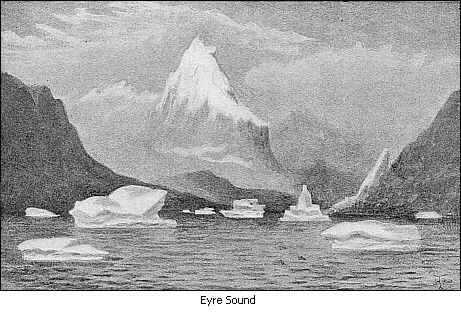
The descent of glaciers to the sea must, I conceive, mainly depend (subject, of course, to a proper supply of snow in the upper region) on the lowness of the line of perpetual snow on steep mountains near the coast. As the snow-line is so low in Tierra del Fuego, we might have expected that many of the glaciers would have reached the sea. Nevertheless I was astonished when I first saw a range, only from 3000 to 4000 feet in height, in the latitude of Cumberland, with every valley filled with streams of ice descending to the sea-coast. Almost every arm of the sea, which penetrates to the interior higher chain, not only in Tierra del Fuego, but on the coast for 650 miles northwards, is terminated by "tremendous and astonishing glaciers," as described by one of the officers on the survey. Great masses of ice frequently fall from these icy cliffs, and the crash reverberates like the broadside of a man-of-war through the lonely channels. These falls, as noticed in the last chapter, produce great waves which break on the adjoining coasts. It is known that earthquakes frequently cause masses of earth to fall from sea-cliffs: how terrific, then, would be the
1. On the Cordillera of central Chile, I believe
the snow-line varies exceedingly in height in different summers. I
was assured that during one very dry and long summer, all the snow
disappeared from Aconcagua, although it attains the prodigious
height of 23,000 feet. It is probable that much of the snow at
these great heights is evaporated, rather than thawed.
2. Miers's Chile, vol. i, p. 415. It is said that the
sugar-cane grew at Ingenio, lat. 32° to 33°, but not in
sufficient quantity to make the manufacture profitable. In the
valley of Quillota, south of Ingenio, I saw some large date-palm
trees.
effect of a severe shock (and such occur here1) on a body like a glacier, already in motion, and traversed by fissures! I can readily believe that the water would be fairly beaten back out of the deepest channel, and then, returning with an overwhelming force, would whirl about huge masses of rock like so much chaff. In Eyre's Sound, in the latitude of Paris, there are immense glaciers, and yet the loftiest neighbouring mountain is only 6200 feet high. In this Sound, about fifty icebergs were seen at one time floating outwards, and one of them must have been at least 168 feet in total height. Some of the icebergs were loaded with blocks of no inconsiderable size, of granite and other rocks, different from the clay-slate of the surrounding mountains.
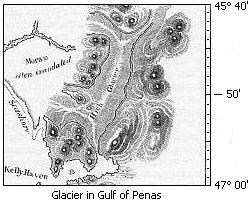
The glacier farthest from the Pole, surveyed during the voyages of the Adventure and Beagle, is in lat. 46° 50', in the Gulf of Penas. It is 15 miles long, and in one part 7 broad, and descends to the sea-coast. But even a few miles northward of this glacier, in the Laguna de San Rafael, some Spanish missionaries2 encountered "many icebergs, some great, some small, and others middle-sized," in a narrow arm of the sea, on the 22nd of the month corresponding with our
1. Bulkeley's and Cummin's Faithful Narrative
of the Loss of the Wager. The earthquake happened August 25,
1741.
2. Agüeros, Desc. Hist. de Chiloé," p. 227.
June, and in a latitude corresponding with that of the Lake of Geneva!
In Europe, the most southern glacier which comes down to the sea is met with, according to Von Buch, on the coast of Norway, in lat. 67°. Now, this is more than 20° of latitude, or 1230 miles, nearer the pole than the Laguna de San Rafael. The position of the glaciers at this place and in the Gulf of Penas may be put even in a more striking point of view, for they descend to the sea-coast within 7½° degrees of latitude, or 450 miles, of a harbour, where three species of Oliva, a Voluta, and a Terebra, are the commonest shells, within less than 9° from where palms grow, within 4½° of a region where the jaguar and puma range over the plains, less than 2½° from arborescent grasses, and (looking to the westward in the same hemisphere) less than 2° from orchideous parasites, and within a single degree of tree-ferns!
These facts are of high geological interest with respect to the climate of the northern hemisphere, at the period when boulders were transported. I will not here detail how simply the theory of icebergs being charged with fragments of rock explains the origin and position of the gigantic boulders of eastern Tierra del Fuego, on the high plain of Santa Cruz, and on the island of Chiloe. In Tierra del Fuego the greater number of boulders lie on the lines of old sea-channels, now converted into dry valleys by the elevation of the land. They are associated with a great unstratified formation of mud and sand, containing rounded and angular fragments of all sizes, which has originated1 in the repeated ploughing up of the sea-bottom by the stranding of icebergs, and by the matter transported on them. Few geologists now doubt that those erratic boulders which lie near lofty mountains have been pushed forward by the glaciers themselves, and that those distant from mountains, and embedded in subaqueous deposits, have been conveyed thither either on icebergs, or frozen in coast-ice. The connection between the transportal of boulders and the presence of ice in some form, is strikingly shown by their geographical distribution over the earth. In South America they are not found farther than 48° of latitude, measured from the southern pole; in North America it appears
1. Geological Transactions, vol. vi, p. 415.
that the limit of their transportal extends to 53½° from the northern pole; but in Europe to not more than 40° of latitude, measured from the same point. On the other hand, in the intertropical parts of America, Asia, and Africa, they have never been observed; nor at the Cape of Good Hope, nor in Australia.1
On the Climate and Productions of the Antarctic Islands.—Considering the rankness of the vegetation in Tierra del Fuego, and on the coast northward of it, the condition of the islands south and south-west of America is truly surprising. Sandwich Land, in the latitude of the north part of Scotland, was found by Cook, during the hottest month of the year, "covered many fathoms thick with everlasting snow;" and there seems to be scarcely any vegetation. Georgia, an island 96 miles long and 10 broad, in the latitude of Yorkshire, "in the very height of summer, is in a manner wholly covered with frozen snow." It can boast only of moss, some tufts of grass, and wild burnet; it has only one land-bird (Anthus correndera), yet Iceland, which is 10° nearer the pole, has, according to Mackenzie, fifteen land-birds. The South Shetland Islands, in the same latitude as the southern half of Norway, possess only some lichens, moss, and a little grass; and Lieut. Kendall2 found the bay in which he was at anchor, beginning to freeze at a period corresponding with our 8th of September. The soil here consists of ice and volcanic ashes interstratified; and at a little depth beneath the surface it must remain perpetually congealed, for Lieut. Kendall found the body of a foreign sailor which had long been buried, with the flesh and all the features perfectly preserved. It is a singular fact that on the two great continents in the northern hemisphere (but not in the broken land of Europe between them) we have the zone of perpetually frozen under-soil in a low latitude—namely, in 56 degrees in North America at the depth of three feet,3 and in 62°
1. I have given details (the first, I believe,
published) on this subject in the first edition, and in the
Appendix to it. I have there shown that the apparent exceptions to
the absence of erratic boulders in certain hot countries are due to
erroneous observations; several statements there given I have since
found confirmed by various authors.
2. Geographical Journal, 1830, pp. 65, 66.
3. Richardson's Append. to Back's Exped. and Humboldt's
Fragm. Asiat. tome ii, p. 386.
in Siberia at the depth of twelve to fifteen feet—as the result of a directly opposite condition of things to those of the southern hemisphere. On the northern continents, the winter is rendered excessively cold by the radiation from a large area of land into a clear sky, nor is it moderated by the warmth-bringing currents of the sea; the short summer, on the other hand, is hot. In the Southern Ocean the winter is not so excessively cold, but the summer is far less hot, for the clouded sky seldom allows the sun to warm the ocean, itself a bad absorbent of heat: and hence the mean temperature of the year, which regulates the zone of perpetually congealed under-soil, is low. It is evident that a rank vegetation, which does not so much require heat as it does protection from intense cold, would approach much nearer to this zone of perpetual congelation under the equable climate of the southern hemisphere, than under the extreme climate of the northern continents.
The case of the sailor's body perfectly preserved in the icy soil of the South Shetland Islands (lat. 62° to 63° S.), in a rather lower latitude than that (lat. 64° N.) under which Pallas found the frozen rhinoceros in Siberia, is very interesting. Although it is a fallacy, as I have endeavoured to show in a former chapter, to suppose that the larger quadrupeds require a luxuriant vegetation for their support, nevertheless it is important to find in the South Shetland Islands a frozen under-soil within 360 miles of the forest-clad islands near Cape Horn, where, as far as the bulk of vegetation is concerned, any number of great quadrupeds might be supported. The perfect preservation of the carcasses of the Siberian elephants and rhinoceroses is certainly one of the most wonderful facts in geology; but independently of the imagined difficulty of supplying them with food from the adjoining countries, the whole case is not, I think, so perplexing as it has generally been considered. The plains of Siberia, like those of the Pampas, appear to have been formed under the sea, into which rivers brought down the bodies of many animals; of the greater number of these only the skeletons have been preserved, but of others the perfect carcass. Now it is known that in the shallow sea on the Arctic coast of America the bottom freezes,1 and does not thaw in spring so soon as the surface
1. Messrs. Dease and Simpson, in Geographical Journal vol. viii, pp. 218 and 220.
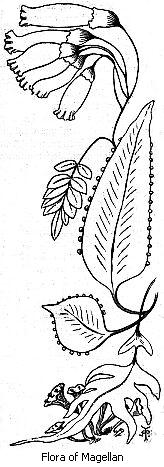
of the land, moreover, at greater depths, where the bottom of the sea does not freeze, the mud a few feet beneath the top layer might remain even in summer below 32°, as is the case on the land with the soil at the depth of a few feet. At still greater depths the temperature of the mud and water would probably not be low enough to preserve the flesh; and hence, carcasses drifted beyond the shallow parts near an arctic coast, would have only their skeletons preserved: now in the extreme northern parts of Siberia bones are infinitely numerous, so that even islets are said to be almost composed of them;1 and those islets lie no less than ten degrees of latitude north of the place where Pallas found the frozen rhinoceros. On the other hand, a carcass washed by a flood into a shallow part of the Arctic Sea, would be preserved for an indefinite period, if it were soon afterwards covered with mud sufficiently thick to prevent the heat of the summer water penetrating to it; and if, when the sea-bottom was upraised into land, the covering was sufficiently thick to prevent the heat of the summer air and sun thawing and corrupting it.
1. Cuvier (Ossemens Fossiles, tome i, p. 151), from Billing's Voyage.
Recapitulation.—I will recapitulate the principal facts with regard to the climate, ice-action, and organic productions of the southern hemisphere, transposing the places in imagination to Europe, with which we are so much better acquainted. Then, near Lisbon, the commonest sea-shells, namely, three species of Oliva, a Voluta, and a Terebra, would have a tropical character. In the southern provinces of France, magnificent forests, intwined by arborescent grasses and with the trees loaded with parasitical plants, would hide the face of the land. The puma and the jaguar would haunt the Pyrenees. In the latitude of Mont Blanc, but on an island as far westward as Central North America, tree-ferns and parasitical Orchideæ would thrive amidst the thick woods. Even as far north as central Denmark humming-birds would be seen fluttering about delicate flowers, and parrots feeding amidst the evergreen woods; and in the sea there we should have a Voluta, and all the shells of large size and vigorous growth. Nevertheless, on some islands only 360 miles northward of our new Cape Horn in Denmark, a carcass buried in the soil (or if washed into a shallow sea, and covered up with mud) would be preserved perpetually frozen. If some bold navigator attempted to penetrate northward of these islands, he would run a thousand dangers amidst gigantic icebergs, on some of which he would see great blocks of rock borne far away from their original site. Another island of large size in the latitude of southern Scotland, but twice as far to the west, would be "almost wholly covered with everlasting snow," and would have each bay terminated by ice-cliffs, whence great masses would be yearly detached: this island would boast only of a little moss, grass, and burnet, and a titlark would be its only land inhabitant. From our new Cape Horn in Denmark, a chain of mountains, scarcely half the height of the Alps, would run in a straight line due southward; and on its western flank every deep creek of the sea, or fiord, would end in "bold and astonishing glaciers." These lonely channels would frequently reverberate with the falls of ice, and so often would great waves rush along their coasts; numerous icebergs, some as tall as cathedrals, and occasionally loaded with "no inconsiderable blocks of rock," would be stranded on the outlying islets; at intervals violent earthquakes would shoot prodigious masses of ice into the waters below. Lastly, some missionaries
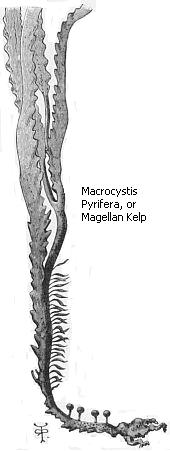
attempting to penetrate a long arm of the sea, would behold the not lofty surrounding mountains, sending down their many grand icy streams to the sea-coast, and their progress in the boats would be checked by the innumerable floating icebergs, some small and some great; and this would have occurred on our twenty-second of June, and where the Lake of Geneva is now spread out!1
1. In the former edition and Appendix, I have given some facts on the transportal of erratic boulders and icebergs in the Antarctic Ocean. This subject has lately been treated excellently by Mr. Hayes, in the Boston Journal (vol. iv, p. 426). The author does not appear aware of a case published by me (Geographical Journal, vol. ix, p. 528), of a gigantic boulder embedded in an iceberg in the Antarctic Ocean, almost certainly one hundred miles distant from any land, and perhaps much more distant. In the Appendix I have discussed at length the probability (at that time hardly thought of) of icebergs, when stranded, grooving and polishing rocks, like glaciers. This is now a very commonly received opinion; and I cannot still avoid the suspicion that it is applicable even to such cases as that of the Jura. Dr. Richardson has assured me that the icebergs off North America push before them pebbles and sand, and leave the submarine rocky flats quite bare; it is hardly possible to doubt that such ledges must be polished and scored in the direction of the set of the prevailing currents. Since writing that Appendix I have seen in North Wales (London Phil. Mag. vol. xxi, p. 180) the adjoining action of glaciers and floating icebergs.